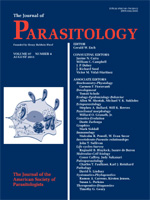Between April 2008 and March 2009, we analyzed the pattern of coccidian oocysts present in the feces of the European bison (Bison bonasus L., 1758) and found 4 species (Eimeria bovis, E. canadensis, E. ellipsoidalis, E. zuernii) previously reported from this host and 3 species (Eimeria alabamensis, E. cylindrica, E. pellita) that are new host and locality records. All the species occurred in bison females, and only 4 occurred in males; E. bovis was the most prevalent in both sexes. The overall prevalence of Eimeria spp. invasion reached 34.7% in cows and 13.9% in bulls. The highest prevalence was noted in early spring, with a peak in April, and the lowest in late autumn and winter. The oocyst count per gram of feces (OPG) varied from 50 to 1,350; no symptoms of clinical coccidiosis were observed. We found a significant influence of winter aggregations of bison on shedding of coccidian oocysts. The prevalence and OPG values were higher in bison congregating in large numbers around winter-feeding sites in comparison to other sites. We suggest that the coming together of cows during the growing season impacts the gender-related differences in prevalence and the number of coccidian species involved. This observation probably results from an increased production of oocysts by sub-clinically infected individuals in high-density bison populations.
How to translate text using browser tools
1 August 2011
The Annual Cycle of Shedding Eimeria Oocysts by European Bison (Bison bonasus) in the Bialowieza Primeval Forest, Poland
Anna M. Pyziel,
Rafal Kowalczyk,
Aleksander W. Demiaszkiewicz
ACCESS THE FULL ARTICLE

Journal of Parasitology
Vol. 97 • No. 4
August 2011
Vol. 97 • No. 4
August 2011




